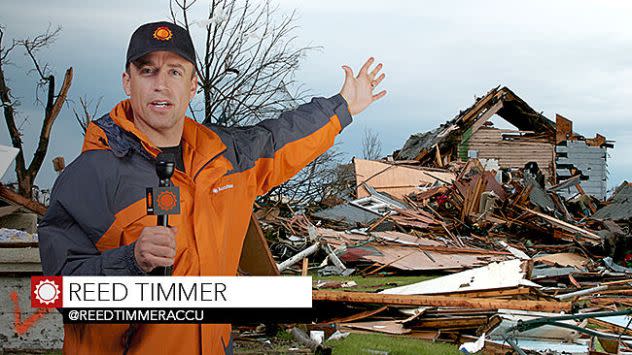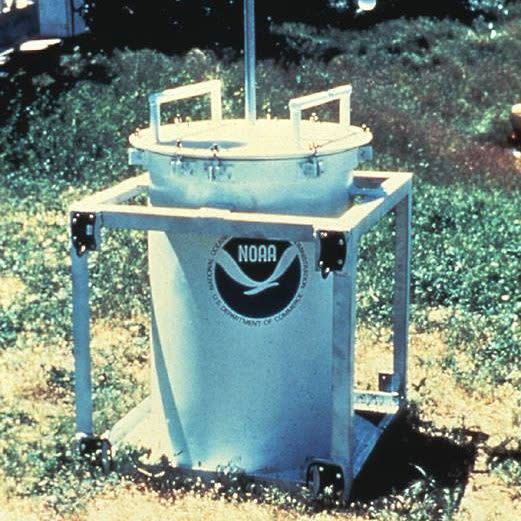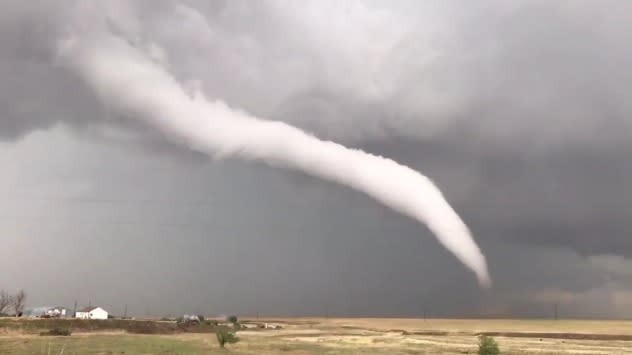55-gallon drum inspired 'character' in one of all-time great weather movies
- Oops!Something went wrong.Please try again later.
- Oops!Something went wrong.Please try again later.
- Oops!Something went wrong.Please try again later.
The blockbuster movie Twister sparked many people's curiosity about storm chasing and meteorology when it arrived in theaters on May 10, 1996. And it also borrowed inspiration from methods meteorologists used in the 1970s for one of its main characters -- a technology that never really took off, so to speak -- but is described by real-life storm chasers today as having been ahead of its time.
The film is set in rural Oklahoma where a TV meteorologist gets roped into chasing storms. Helen Hunt and Bill Paxton starred in the fast-action movie and depicted a married couple on the verge of divorce. They came together to put themselves in the path of violent severe weather in the name of science. Their performance not only entertained audiences and made heart pounds but also inspired a slew of future scientists in real life.
Reed Timmer, a professional storm chaser for more than two decades, reminisced back on the hit film for the 25th anniversary in 2021 and explained to AccuWeather how the film influenced both the storm chasing industry at large and his career personally.
Timmer, who has worked for AccuWeather in various roles over the years, told AccuWeather's Lincoln Riddle that he vividly remembers watching Twister, his all-time favorite movie, in theaters 25 years ago.
"I was in high school at the time. I had just turned 16, and I remember watching Twister in the theater. I had butterflies in my stomach," Timmer recalled.
Timmer had just earned his driver's license a couple of months before the movie came out, and he already had a couple of storm chases under his belt prior to its release, including chasing lake-effect snow and also some spring thunderstorms in Michigan.
 |
Timmer, who has now witnessed more than 700 tornadoes, more than 40 hurricanes and tropical cyclones and an array of other types of extreme weather, such as blizzards, didn't always have an affinity toward severe weather.
Timmer said that when he was a child he "was deeply afraid of thunder and lightning," but that fear ended abruptly. "Then I woke up one morning -- and it was like a light switch went off," Timmer said.
Timmer became obsessed with storms.
"Before watching Twister, I already knew this is what I wanted to do for the rest of my life and [the movie] only gave me that much more excitement and passion to continue following my goal and to become a professional storm chaser. And now here I am, 25 years later, still chasing down tornadoes," Timmer said.
When Twister was released in theaters, Timmer was already passionate about storm chasing, but the popular film took his dream to another level.
"I was on a trajectory to become a storm chaser and it only solidified that track," Timmer recalled, adding that seeing people storm chase and doing the job for a living with a passion equal to his own helped. "Ever since I saw that movie I was even more dedicated to devoting my entire life to chasing down storms," Timmer said.
Timmer did follow that passion and has set out to chase down all manner of extreme weather. So much that he coined a phrase that he ends many storm updates with: "Never stop chasing."
And Timmer wasn't alone. He said the movie inspired an entire generation of meteorologists and storm chasers.
"When I got down to the University of Oklahoma my freshman year, there were dozens and dozens of students there. I think we had over 200 people in the freshmen class in meteorology there, and many of those were inspired by the movie Twister that came out in 1996 -- and many of the meteorologists and storm chasers that are going strong today were certainly inspired by that movie," Timmer said.
In the movie, the storm chasers were dedicated to science as well, like many real-life storm chasers today. During the film, the meteorologists deployed Dorothy, which was a ground probe that was based on a real-life attempt to research tornadoes in order to gain a better understanding of nature's tempests. Researchers tried to place equipment in a tornado's path to measure wind speed and other meteorological variables at ground level.
 |
NSSL researchers attempted to intercept a tornado with TOTO, a 55-gallon drum, in order to study tornadoes. The attempt inspired screenwriters Michael Crichton and Ann Marie Martin, who went on to write the story behind the 1996 blockbuster hit. (NOAA National Severe Storms Laboratory) |
"TOTO, a 55-gallon drum that researchers attempted to place in the path of a tornado, inspired screenwriters Michael Crichton and Ann Marie Martin to develop the story that would become the 1996 movie Twister. Released 20 years ago today, Twister remains an important part of NSSL history," The National Oceanic and Atmospheric Administration (NOAA) National Severe Storms Laboratory (NSSL) said in a post on Facebook on the day of the film's 25th anniversary.
Researchers first attempted to gather data from tornadoes in the 1970s, with the aim of trying to improve the understanding of tornadoes to better warn the public, according to the NSSL.
Dr. Al Bedard and Carl Ramzy were the scientists from the NOAA Environmental Research Library, the predecessor to NSSL, who created Toto, which was short for the TOtable Tornado Observatory. Aptly named Toto after Dorothy's dog from the 1939 film The Wizard of Oz, which began with a tornado striking Kansas, the device was designed to measure and record the data gathered by anemometers, instruments used to measure wind speed and direction, pressure sensors and humidity sensors.
Groups, led by Dr. Howi Bluestein from the University of Oklahoma and NSSL, attempted to deploy Toto squarely in tornadoes' tracks. A direct hit never happened, though. Its closest encounter was in 1984 when it was knocked over by the edge of a weak tornado. The device was retired in 1987.
 |
TOTO, a red 55-gallon barrel outfitted with weather sensors, was used by NOAA researchers to study tornadoes. Dorothy and D.O.T.3 are props based on TOTO and were used in the movie 'Twister.' All three are on display at the National Weather Center in Norman, Oklahoma. (NOAA National Severe Storms Laboratory) |
Twister adapted that concept with the idea of Dorothy, a large barrel that sent hundreds of live-streaming sensors into the tornado, lofted by the tornadic winds. The device in the movie was deployed in the path of a tornado and launched sensors that live-streamed data and provided a 3-D X-ray of the tornado inside.
A version of Dorothy and its competitor, D.O.T.3 were in recent years put on display at the NWS office in Norman, Oklahoma.
The 1996 film was "definitely ahead of its time in terms of the actual science that we could do around tornadoes," Timmer said.
Now meteorologists and storm chasers are launching rockets and live-streaming sensors in tornadoes in real life more than two decades later.
The movie actually helped inspire tornado science, Timmer said, and he explained that, in recent years, researchers have been able to design live-streaming sensors. Meteorologists are able to view data as the probes are launched inside of a tornado.
These feats were performed in a similar way to the hit movie that debuted more than two decades ago.
"[In 2019] we launched sensors into a tornado by model rocket, and they were able to stream that live data back to the Dominator 3, our armored vehicle, as we intercepted that tornado," Timmer explained.
One of those sensors was lofted over 30 miles away from Timmer's location at speeds of up to 190 miles per hour. That interception in May 2019 gave him and fellow researchers the first-ever look, in real-time, at just how strong a violent tornado was as it charged across northeastern Kansas, heading toward Kansas City.
In 2022, Timmer's drone video of the Andover tornado was analyzed to detect debris spinning around the tornado, reminiscent of the scene in the movie where the sensors in Dorothy go airborne.
Each one of these tracks is a piece of Debris from the original high-res version of @ReedTimmerAccu's video of the Andover, KS Tornado. "Dashed" tracks indicate a flat object rotating (gaps in the track are where it's edge on to the drone) pic.twitter.com/wuJEae1mRu
— ChasinSpin (@ChasinSpin) May 7, 2022
"Our science mission with the Dominators was inspired in part by the movie Twister and the Dorothy probe that was deployed in the path of that tornado," Timmer said.
CLICK HERE FOR THE FREE ACCUWEATHER APP
Timmer's Dominator is an armored storm-chasing vehicle that's designed to get inside, if not up close to tornadoes. The whole purpose of the Dominator, Reed explained, is to collect data inside of supercell storms that cannot safely be collected from a regular vehicle.
"We were already getting really close to these storms in a regular beater vehicle. So we figured we would modify our vehicle with protective armor. It's very aerodynamic as well, so that can help keep the Dominator on the ground when we're inside these tornadic winds," Timmer said.
Since Timmer has chased down hundreds of tornadoes -- and has even had his share of extremely up-close encounters with twisters in real life, including a massive wedge tornado in Wray, Colorado, that generated viral video footage five years ago, he can weigh in on whether the film's portrayal of being inside a tornado was accurate.
"It definitely is different inside of a real tornado than [what] was depicted inside of the movie Twister," Timmer said. One reason that the tornadoes in the movie were not the best representation of a real tornado could be that the filmmakers used a Boeing 707 plane engine to generate wind in some scenes, he said.
"In the movie Twister, they were strapped to a drainage pipe, looked up through the eye of the tornado and you could see the blue sky above. There was lightning inside of the condensation funnel as well," Timmer said.
 |
A tornado Reed Timmer captured near Keenesburg, Colorado. (AccuWeather / Reed Timmer) |
And Timmer said intercepting a tornado in real life is more terrifying even than the movie depicted.
"It's a lot less beautiful in there. The tornado doesn't really have a well-defined eye in the middle of it. It's very turbulent. You have sub-vortices that are rotating around in those multiple vortex tornadoes," Timmer said.
Timmer explained that inside a tornado he saw dust and spray flying around everywhere as well as condensation. Plus, it can be a bit painful, he said.
"Being inside of a tornado is almost like a massive rotating fog bank, and you have massive pressure falls inside of a tornado as well. So your eardrums are blowing out, your ears are popping inside of the tornado and it definitely is absolutely terrifying being inside of a tornado," Timmer said, adding that the film didn't quite capture that. Timmer noted that is the case, "Even with the protection of the Dominators with the armored vehicles and the spikes that are able to bury into the ground to keep the Dominator anchored to the ground."
The movie's popularity shows no signs of waning, even a quarter-century after its release. In 2019, AccuWeather ran an informal poll aimed at identifying the greatest weather movie ever. Twister won in the final round as 75% of AccuWeather readers who took part chose it over The Perfect Storm.
Keep checking back on AccuWeather.com and stay tuned to the AccuWeather Network on DirecTV, Frontier, Spectrum, FuboTV, Philo, and Verizon Fios.




